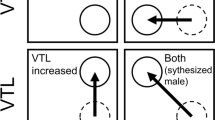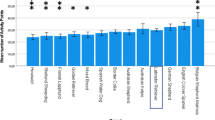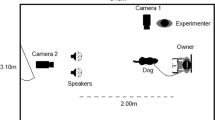Abstract
Members of two behaviorally contrasting lines of purebred pointer dogs were tested during development at ages 3, 6, and 9 months for heart-rate response to the presence of and petting by a human. Dogs of the Nervous line, which show retreat, fearfulness, and freezing postures in the presence of humans and novel objects, exhibited at all ages a reduced heart rate with the person in the chamber and during petting. Dogs of the Normal line, which show friendliness and playfulness with humans and exploratory behavior toward novel objects, exhibited at 6 and 9 months an increased heart rate with the person in the chamber and a reduction of heart rate toward beseline during petting. Reciprocal crosses of the two lines clearly showed at 3 months the pattern characteristic of the male parent, while at 6 months the pattern for both hybrid types did not resemble the Nervous-line bradycardia pattern, but showed reduced aspects of the patterns of both lines. The data suggest a genetic explanation for markedly different physiologic effects of an emotion-provoking stimulus, which elicits what appears to be a negative emotional effect in one line and a positive emotional effect in the other line.
Similar content being viewed by others
References
Adolph, E. F. (1967). Ranges of heart rates and their regulations at various ages (rat).Am. J. Physiol. 212:595–602.
Angel, C., Murphree, O. D., and DeLuca, D. C. (1974). The effects of chlordiazepoxide, amphetamine and cocaine on bar-press behavior in normal and genetically nervous dogs.Dis. Nerv. Syst. 35:220–223.
Brown, C. J., Murphree, O. D., and Newton, J. E. O. (1978). The effect of inbreeding on human aversion in pointer dogs.J. Hered. 69:362–365.
Chapin, J. L., and Newton, J. E. O. (1979). Parallel between antianxiety and cardiovascular effects of chlordiazepoxide in genetically nervous dogs.Pav. J. Biol. Sci. 14:1–9.
Drescher, M. A., Gantt, W. H., and Whitehead, W. E. (1980). Heart rate response to touch.Psychosom. Med. 42:559–565.
Dykman, R. A., and Gantt, W. H. (1960). Experimental psychogenic hypertension; Blood pressure changes conditioned to painful stimuli (schizokinesis).Bull. Johns Hopkins Hosp. 107:72–89.
Dykman, R. A., Murphree, O. D., and Peters, J. E. (1969). Like begets like: Behavioral tests, classical autonomic and motor conditioning, and operant conditioning in two strains of pointer dogs.Ann. N.Y. Acad. Sci. 159:976–1007.
Dykman, R. A., Murphree, O. D., and Reese, W. G. (1979). Familial anthropophobia in pointer dogs?Arch. Gen. Psychiat. 36:988–993.
Fox, M. W. (1966). Brain to body relationships in ontogeny of canine brain.Experientia 22:111–112.
Galosy, R. A., Clarke, L. K., and Mitchell, J. H. (1978). Cardiac changes to signalled shock avoidance in dogs.Physiol. Behav. 21:33–38.
Gantt, W. H., Newton, J. E. O., Royer, F. L., and Stephens, J. H. (1966). Effect of Person.Cond. Reflex 118–35.
Gellhorn, E., and Loofbourrow, G. N. (1963).Emotions and Emotional Disorders, Harper and Row, New York, p. 192.
Gregg, D. E. (1966). The output of the heart and the regulation of its action. In Best, C. H., and Taylor, N. B. (eds.),The Physiological Basis of Medical Practice, Williams and Wilkins, Baltimore, p. 795.
Hofer, M. A. (1970). Cardiac and respiratory function during sudden prolonged immobility in wild rodents.Psychosom. Med. 32:633–647.
Lynch, J. J., Thomas, S. A., Mills, M. S., Mainow, K., and Katcher, A. H. (1974). The effects of human contact on cardiac arrhythmia in coronary care patients.J. Nerv. Ment. Dis. 158:88–99.
Lyon, R. A. (1950). The heart and circulation in health and disease. In Nelson, W. E. (ed.),Textbook of Pediatrics, W. B. Saunders, Philadelphia, p. 1021.
Murphree, O. D., and Dykman, R. A. (1965). Litter patterns in the offspring of nervous and stable dogs. I. Behavioral tests.J. Nerv. Ment. Dis. 141:321–332.
Murphree, O. D., and Newton, J. E. O. (1971). Schizokinesis: Fragmentation of performance in two strains of pointer dogs.Cond. Reflex 6:91–100.
Murphree, O. D., Peters, J. E., and Dykman, R. A. (1967). Effect of person on nervous, stable and crossbred pointer dogs.Cond. Reflex 2:273–276.
Murphree, O. D., Peters, J. E., and Dykman, R. A. (1969). Behavioral comparisons of nervous, stable and cross bred pointers at ages 2, 3, 6, 9 and 12 months.Cond. Reflex 4:20–23.
Murphree, O. D., Angel, C. A., DeLuca, D. C., Newton, J. E. O., and Farris, H. E., Jr. (1974). Nervous dogs: A partial model for psychiatric research.Lab Anim. 3:16–19.
Newton, J. E. O. (1980). Unpublished observations.
Newton, J. E. O., and Gantt, W. H. (1968). The history of a catatonic dog.Cond. Reflex 3:45–61.
Newton, J. E. O., Dykman, R. A., and Chapin, J. L. (1978). The prediction of abnormal behavior from autonomic indices in dogs.J. Nerv. Ment. Dis. 166:635–641.
Raghuprasad, P. K. (1979). Venipuncture and cardiac arrest.JAMA 241:134–135.
Reite, M., Short, R., Kaufman, I. C., Stynes, A. J., and Pauley, J. D. (1978). Heart rate and body temperature in separated monkey infants.Biol. Psychiat. 13:91–105.
Richter, C. P. (1957). On the phenomenon of sudden death in animals and man.Psychosom. Med. 19:191–198.
Stern, S., and Kerem, A. (1978). Exterme sinus bradycardia following routine venipuncture.JAMA 239:403–404.
Wenger, M. A., Jones, F. N., and Jones, M. H. (1956).Physiological Psychology, Henry Holt, New York, p. 270.
Wilder, J. (1957). The law of initial values in neurology and psychiatry. Facts and problems.J. Nerv. Ment. Dis. 125:73–86.
Winer, B. J. (1962).Statistical Principles in Experimental Design, McGraw-Hill, New York, p. 80.
Wolf, S. (1967). The end of the rope.Can. Med. Assoc. J. 97:1022–1025.
Author information
Authors and Affiliations
Additional information
This research was supported in part by the Veterans Administration Research Service and in part by the Marie Wilson Howells Memorial Fund of the Department of Psychiatry and Behavioral Sciences, University of Arkansas for Medical Sciences.
Rights and permissions
About this article
Cite this article
Newton, J.E.O., Lucas, L.A. Differential heart-rate responses to person in nervous and normal pointer dogs. Behav Genet 12, 379–393 (1982). https://doi.org/10.1007/BF01065631
Received:
Accepted:
Issue Date:
DOI: https://doi.org/10.1007/BF01065631




